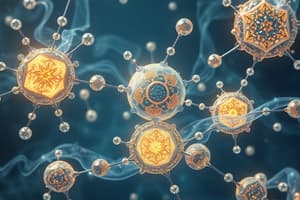Podcast
Questions and Answers
What type of gas will not condense because the molecules do not attract each other?
What type of gas will not condense because the molecules do not attract each other?
- Liquid
- Plasma
- Real gas
- Ideal gas (correct)
Collisions between molecules in an ideal gas are perfectly elastic.
Collisions between molecules in an ideal gas are perfectly elastic.
True (A)
What type of gas exerts an attraction on gas particles passing close to one another?
What type of gas exerts an attraction on gas particles passing close to one another?
Real gas
What happens to the kinetic energy of colliding particles during an elastic collision if temperature is constant?
What happens to the kinetic energy of colliding particles during an elastic collision if temperature is constant?
If two gases have the same temperature and energy but different molecular masses, which molecules will have the greater speed?
If two gases have the same temperature and energy but different molecular masses, which molecules will have the greater speed?
Explain why a strong smelling gas released from a container in the middle of a room is soon detected in all areas of that room.
Explain why a strong smelling gas released from a container in the middle of a room is soon detected in all areas of that room.
Explain why the rate of effusion of a gas increases as it is heated.
Explain why the rate of effusion of a gas increases as it is heated.
List the following gases in order of rate of effusion, from lowest to highest: (a) He (b) Xe (c) HCl (d) Cl2: Fill in the order with letters.
List the following gases in order of rate of effusion, from lowest to highest: (a) He (b) Xe (c) HCl (d) Cl2: Fill in the order with letters.
Explain why certain gases are ordered in effusion rates from lowest to highest based on kinetic-molecular theory.
Explain why certain gases are ordered in effusion rates from lowest to highest based on kinetic-molecular theory.
Explain why polar gas molecules experience larger deviations from ideal behavior than non-polar molecules.
Explain why polar gas molecules experience larger deviations from ideal behavior than non-polar molecules.
Flashcards are hidden until you start studying
Study Notes
Ideal Gas vs. Real Gas
- Ideal gases do not exhibit intermolecular attractions, preventing condensation.
- Collisions between ideal gas molecules are perfectly elastic, meaning kinetic energy is conserved in collisions.
- Real gases experience intermolecular attractions, affecting their behavior under certain conditions.
Kinetic Energy and Collision
- During elastic collisions at constant temperature, kinetic energy is transferred between molecules, but the overall kinetic energy remains unchanged.
- Gases with lower molecular mass will have higher speeds compared to those with greater molecular mass when at the same temperature and energy.
Kinetic-Molecular Theory Applications
- Kinetic-molecular theory explains that gas molecules are in rapid, constant random motion, which accounts for the spread of a strong-smelling gas throughout a room.
- When a gas is heated, the increased temperature causes gas molecules to move faster, resulting in an increased rate of effusion through small openings.
Rate of Effusion
- Order of gases by rate of effusion (from lowest to highest): Xenon (Xe), Chlorine (Cl2), Hydrogen Chloride (HCl), Helium (He).
- Gases at the same temperature have identical average kinetic energy; thus, heavier gas molecules move slower than lighter ones. The order of gases reflects their molar mass, arranged from heaviest to lightest.
Polar vs. Non-Polar Molecules
- Polar gas molecules show greater deviations from ideal gas behavior due to attractions between neighboring polar molecules, influencing their straight-line motion and interactions compared to non-polar molecules under constant conditions.
Studying That Suits You
Use AI to generate personalized quizzes and flashcards to suit your learning preferences.




